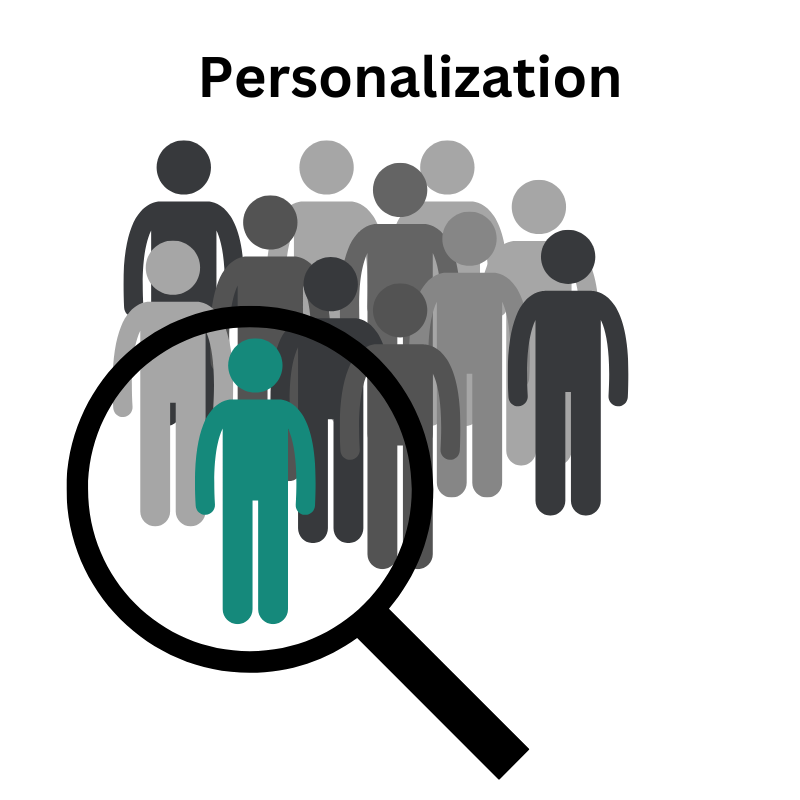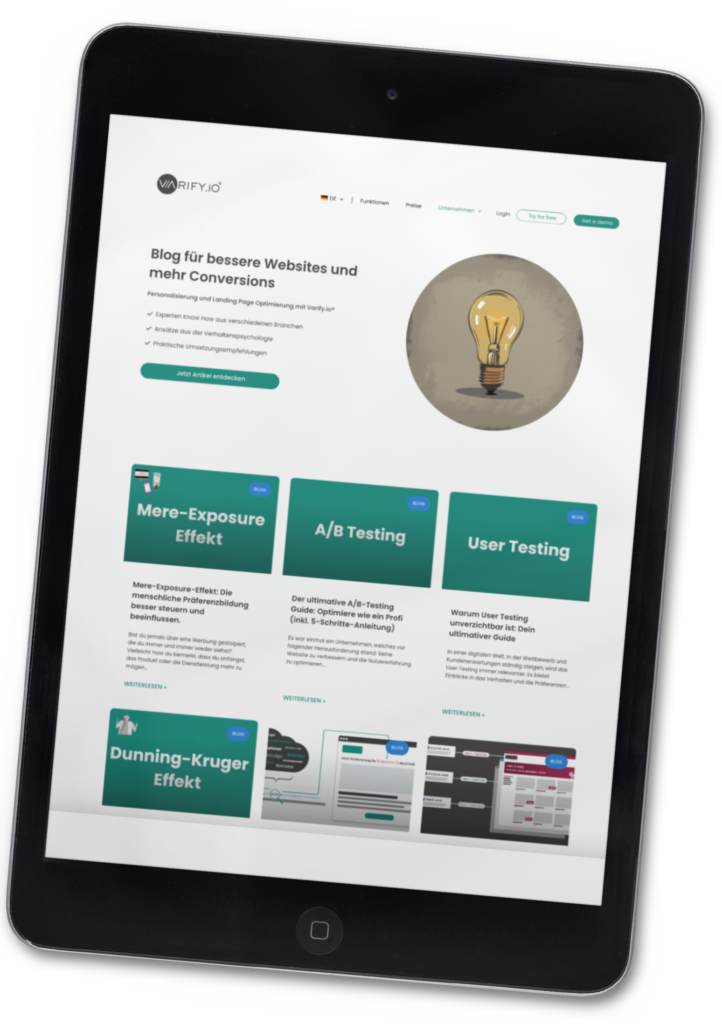
Personalization is the key to standing out in a crowded market. Customers today expect customized experiences that directly address their needs and desires. Companies that fail to respond to these demands will quickly lose out. However, success lies not only in customization, but in the ability to deliver targeted, relevant content and offers at the right time. Personalization is more than just a trend, it is the basis for long-term customer loyalty and business success.

Table of contents
What is personalization? A clear definition
Personalization refers to the practice of tailoring offers, content or experiences to the individual needs, preferences or behaviour of a user. The aim is to offer customers what they actually want before they realize it themselves. A distinction is made between different approaches:
User-centric personalization focuses on the individual data of a user, such as purchasing behaviour or interests.
Contextual personalization, on the other hand, takes into account the user's current situation, such as their location or the device they are using to access the platform.
Both approaches help to improve the user experience and increase the relevance of content, which ultimately leads to greater customer loyalty.

How does personalization work? The technologies behind it
Personalization is based on advanced technologies that enable companies to collect and analyze data and deliver tailored experiences in real time. The main technologies behind personalization are:
- Algorithms and machine learning: These technologies analyze user behaviour and make predictions about their needs. They recognize patterns in the data and can thus make personalized recommendations that become more accurate the more interactions the user has.
- Artificial intelligence (AI): AI is used to process large amounts of data in real time and then deliver relevant, personalized content. It can also automatically recognize the preferred type of communication or offers and adapt them accordingly.
- Data mining: This involves discovering patterns and correlations in large volumes of data. Companies use this technology to gain deeper insights into their customers' behavior and target their offers.
These technologies make it possible for personalization to work not only reactively, but also proactively. For example, a website can suggest products to visitors that are likely to interest them based on their previous behavior or similar user profiles.
Personalization in marketing
Personalization has an enormous influence on the effectiveness of marketing campaigns. It not only helps to address the right target groups, but also increases the relevance and effectiveness of communication. Some of the most important areas of application for personalization in marketing are
Personalized emails: One of the most common and effective applications. Instead of sending mass emails, customers receive customized content tailored to their interests and behavior. These personalized emails often have higher open and click-through rates because they specifically address the recipient's needs.
Personalized websites: When visitors visit a website, they are shown individually tailored content and products based on their previous behaviour or preferences. This not only improves the user experience, but can also significantly increase conversion rates.
Personalized advertising: By analyzing data from different channels, advertisements can be targeted to the right people. This increases the chance that users will respond to the ads as they are tailored to their interests and needs.
Companies that successfully implement personalization can achieve much higher customer loyalty and significantly improve the customer experience. A good example of this is Netflix, which provides its users with personalized recommendations based on their viewing habits - a technique that has had a significant impact on the company's success.
A/B testing in personalization
A/B testing is one of the most effective methods for continuously optimizing personalized content. It involves comparing two versions of a page or ad to find out which performs better.
What is A/B Testing?
Two versions of a page or ad are tested to measure which version achieves better results. Only one variable is changed, e.g. the approach in an email or the design of a landing page.
How does A/B testing help?
A/B tests can be used to constantly improve personalized content. For example, it is possible to test how different personalized approaches or offers influence the conversion rate. The variant that works better is then further optimized.
Continuous optimization
A/B tests provide valuable data that companies can use to tailor their personalized measures ever more precisely to the needs of their target group. This leads to better conversion rates and more satisfied users. With tools such as Varify.io, this process can be accelerated even further: Varify.io enables rapid implementation of A/B tests on websites and landing pages. This allows marketing teams to continuously optimize the effectiveness of personalized content and adapt their campaigns quickly and efficiently.
Success metrics: How do you measure the effectiveness of personalization?
To measure the success of personalization, companies need to keep an eye on the right KPIs (Key Performance Indicators). These metrics provide information on how well personalized measures are received by users and what impact they have on business results.
Conversion rate: One of the most important metrics. It shows how many visitors to a personalized website or landing page perform a desired action, e.g. make a purchase or fill out a form. A high conversion rate is a direct sign that personalization is effective.
Customer Engagement: This metric measures how actively users interact with personalized content. This includes metrics such as click rate, time spent on the website and social shares. The more engagement, the more relevant the personalized content is for the target group.
Customer Lifetime Value (CLV): CLV indicates how much a customer is worth over the entire duration of their relationship with a company. Personalization can help to increase customer loyalty and CLV by providing customers with a continuously relevant experience.
By continuously monitoring these metrics, companies can measure the success of their personalization strategy and make targeted adjustments. In this way, they ensure that the personalized measures also contribute to increasing business success in the long term.
Personalization and data protection
In the age of personalization, data protection is an increasingly important aspect that companies must not ignore. While the collection and analysis of user data forms the basis for customized experiences, the protection of user privacy must be guaranteed at all times.
- Challenges in data protection
The biggest challenge is to find a balance between personalized experiences and maintaining privacy. Users want to benefit from the advantages of personalization without feeling that their personal data is being misused or collected without their knowledge. - Solutions for data protection
Companies can ensure that they gain the trust of their customers through transparent privacy policies and compliance with regulations such as the GDPR. They can also give users control over their data, e.g. through opt-in mechanisms where users must actively consent to their data being used for personalization purposes. - Responsible personalization
Responsible personalization means that companies handle the collected data responsibly and only use it for the purpose that the user has accepted. This builds a sustainable and trusting relationship with the customer.
The future of personalization - trends and developments
Personalization does not stand still; it continues to develop with every technological innovation. Companies that want to be at the forefront should not only master current standards, but also actively observe and test upcoming trends.
- Artificial intelligence on a new level
In future, AI will be able to predict even more precisely what users need, often before they know it themselves. Predictive personalization, i.e. the anticipatory adaptation of content, will become the norm. - Hyper-personalization through real-time data
The processing of data in real time enables an even more personalized approach. Websites and apps react immediately to user behavior and adapt content dynamically, e.g. depending on where someone is currently located or how often they have looked at a particular product. - Virtual and augmented reality
Personalized VR and AR experiences open up completely new possibilities - for virtual showrooms, tailor-made product experiences or individual training courses, for example. There is enormous potential here, particularly in the e-commerce and B2B sectors. - Multi-channel consistency
The personalization of the future is seamless across all channels. Users receive a consistent experience, whether via website, app, email or voice assistant.
Conclusion
Personalization is no longer a "nice-to-have", but a prerequisite for relevance, differentiation and genuine customer loyalty. Anyone who uses standardized communication today loses reach, relevance - and trust.
Whether through intelligent recommendations, context-based content or precise A/B testing: companies that use personalization strategically not only improve their conversion rate, but also create an experience that keeps users coming back.
It is not just the technology that is important, but the approach: those who understand users, take them seriously and give them control over their data create long-term relationships on an equal footing.
What you can do now:
Check which personalization options already exist in your company.
Start initial tests, e.g. with Varify.io.
Measure your results. Optimize continuously.
And: Always think of personalization from your users' perspective.
Individual references
Pillai, R., & Sivathanu, B. (2024): Artificial Intelligence for Personalized Marketing and Consumer Behavior Analysis. Social Science Research Network (SSRN). [Accessed on: 04.04.2025]
- Smyth, B., & Cotter, P. (2007): User-centred versus system-centred evaluation of a personalization system. Information Processing & Management [Accessed on: 04.04.2025]

